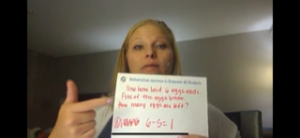
30 Nov Two-Step Story Problems
Story problems start in second grade and continue while increasingly getting harder. It is our job to ensure that we provide our students with the best opportunity of learning how to see a two-step story problem and what to do when they find themselves presented with one. There are things we can do and things we should not do to help our students progress.
WHAT NOT TO DO
When a student is presented with a two-step story problem, do not have them circle or underline numbers. This is not helpful to them as students become reliable on those circles and underlined numbers. This can be counter-productive as there are story problems that have hidden numbers within the problem. If a student relies solely on their circled or underlined numbers, they will miss a huge part of the story problem.
As teachers, we tend to assist our students too much. For example, we let them know we will be working on two-step story problems. Don’t do this anymore. Let the students figure out what they are doing and acknowledge that this is a two-step story problem in front of them.
WHAT TO DO
Story problems are hard. So there are ways to help students understand what they are doing better. The first thing to ensure is that the student re-reads the story problem at least three times. My method is to read the problem out loud to the students. Have the students read the story problem out loud followed by reading the story problem to themselves another three times. I tell them that I will be removing the story problem to help get the students ready to remember what the story is.
Once they are done reading, have students act out what the story problem is about. It doesn’t have to have the specifics yet, as we want students to thoroughly understand what the story is actually about. Students can pair up and use their hands to show what is happening in the problem.
Look at the work of each student. Read back to them what they have actually written down. See if it matches what the story problem is actually asking. Example: your picture shows three hens with 6 eggs each, is that the story? (The child realizes the story is 6 hens with three eggs each). Telling the story back that students are telling with their equations or models is one of the best ways to get students to see how to revise thinking.

A lot of times, students will guess what they write down and hope for the best. By reading what they actually write down, you are helping them understand what their error was. We do not want to dumb things down for our students, we simply want to make them work to fully understand how to solve the problem.
Ask the students if this is what the story is. If they say no, reiterate to them that this is what they have written down. By ensuring that students understand what the story is saying, we can ensure that students understand what the question is that needs to be solved.
There is a second way to help students with story problems. Start with the last question first.
This should alert students to know this is a two-step story problem as there are two unknown factors within their equation. Start out by asking students what they know. Use boxes to show that they are missing information. Break everything down step by step so they find the answers themselves.

Once the student finds the information and has determined the method to use, help them go back and solve the problem. The main key is not to skip a step and not to give the answers to the students.

Just remember when the students are ready to solve the problem, to start over with each step as you talk them through the process to solve this two-step story problem.
When it comes to two-step story problems, it is not about the quantity that the students do. What is important is the quality and understanding that your students complete the problems with. This means that if you only get through two-story problems for the day, you are right on track.
You can find more information on my website: www.empowerlearngrow.com
If you want more examples, be sure to watch my youtube video on this topic:



Sorry, the comment form is closed at this time.